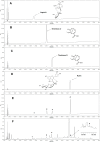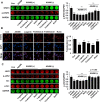Acetone Extract of Cornus officinalis Leaves Exerts Anti-Melanoma Effects via Inhibiting STAT3 Signaling
- PMID: 34093025
- PMCID: PMC8169088
- DOI: 10.2147/OTT.S308371
Acetone Extract of Cornus officinalis Leaves Exerts Anti-Melanoma Effects via Inhibiting STAT3 Signaling
Abstract
Purpose: This research aims to investigate the intervention and mechanism of 50% acetone extract of C. officinalis leaves (SZYY) on melanoma xenografts.
Patients and methods: Tumor size and cardiac function were measured via ultrasound. The accumulation of 2-deoxy-D-glucose (2-DG) in tumor tissue was examined with near-infrared in vivo imaging. Flow cytometry was performed to assess apoptosis and reactive oxygen species (ROS) levels in tumor and immune cells in spleen. The levels of inflammatory cytokines in serum were detected by cytometric bead array. The expression of proliferation-, apoptosis-, and angiogenesis-related proteins in tumor cells was measured to evaluate the underlying mechanisms. Subsequently, the effects of four compounds separated from SZYY on the proliferation and migration of A375 cells and STAT3 signaling were examined. The peak identification and contents of the four components were performed via high-performance liquid chromatography (HPLC). Finally, we evaluated the inhibitory effects of STAT3 overexpression on the cytotoxic activity of four constituents in A375 cells.
Results: SZYY inhibited the growth and glycolysis of melanoma xenograft in mice, improved cardiac function, increased the percentages of macrophages, neutrophils, and lymphocytes in spleen, reduced the levels of IL-6, IL-17A, TNF-α, and IFN-γ in serum, promoted apoptosis and oxidative stress in tumor tissues, and inhibited STAT3 phosphorylation and expression of angiogenic factors. Chemical analysis showed that SZYY is rich in loganin, rutin, triohimas C, and triohimas D, which all could restrain the proliferation and migration of A375 cells and inhibit the phosphorylation and nuclear translocation of STAT3. Moreover, STAT3 overexpression could diminish the cytotoxic activity of four compounds on A375 cells.
Conclusion: SZYY could exert anti-melanoma effects via inhibiting STAT3 signaling to induce apoptosis and inhibit tumor angiogenesis. Its active ingredients might be loganin, rutin, triohimas C, and triohimas D.
Keywords: Cornus officinalis; STAT3; angiogenesis; apoptosis; melanoma.
© 2021 Xu et al.
Conflict of interest statement
The authors report no conflicts of interest in this work.
Figures








Similar articles
-
Raw and salt-processed Achyranthes bidentata attenuate LPS-induced acute kidney injury by inhibiting ROS and apoptosis via an estrogen-like pathway.Biomed Pharmacother. 2020 Sep;129:110403. doi: 10.1016/j.biopha.2020.110403. Epub 2020 Jun 20. Biomed Pharmacother. 2020. PMID: 32574970
-
Dihydroartemisinin inhibits melanoma by regulating CTL/Treg anti-tumor immunity and STAT3-mediated apoptosis via IL-10 dependent manner.J Dermatol Sci. 2020 Sep;99(3):193-202. doi: 10.1016/j.jdermsci.2020.08.001. Epub 2020 Aug 9. J Dermatol Sci. 2020. PMID: 32859456
-
Cornus mas and Cornus officinalis-A Comparison of Antioxidant and Immunomodulatory Activities of Standardized Fruit Extracts in Human Neutrophils and Caco-2 Models.Plants (Basel). 2021 Oct 30;10(11):2347. doi: 10.3390/plants10112347. Plants (Basel). 2021. PMID: 34834710 Free PMC article.
-
The JAK2/STAT3 pathway is involved in the anti-melanoma effects of brevilin A.Life Sci. 2020 Jan 15;241:117169. doi: 10.1016/j.lfs.2019.117169. Epub 2019 Dec 14. Life Sci. 2020. PMID: 31843524
-
Quinalizarin induces cycle arrest and apoptosis via reactive oxygen species-mediated signaling pathways in human melanoma A375 cells.Drug Dev Res. 2019 Dec;80(8):1040-1050. doi: 10.1002/ddr.21582. Epub 2019 Aug 20. Drug Dev Res. 2019. PMID: 31432559
Cited by
-
Angiogenesis as a Therapeutic Target of (Poly)phenols: Tackling Cancer and Vascular-Related Complications.Mol Nutr Food Res. 2025 Aug;69(15):e70110. doi: 10.1002/mnfr.70110. Epub 2025 May 15. Mol Nutr Food Res. 2025. PMID: 40370203 Free PMC article. Review.
-
Eriodictyol and Homoeriodictyol Improve Memory Impairment in Aβ25-35-Induced Mice by Inhibiting the NLRP3 Inflammasome.Molecules. 2022 Apr 12;27(8):2488. doi: 10.3390/molecules27082488. Molecules. 2022. PMID: 35458684 Free PMC article.
-
Research Progress of Natural Compounds from Chinese Herbal Medicine in the Treatment of Melanoma.Curr Treat Options Oncol. 2025 Jul;26(7):533-568. doi: 10.1007/s11864-025-01322-8. Epub 2025 May 15. Curr Treat Options Oncol. 2025. PMID: 40372659 Review.
-
A comprehensive review of Cornus officinalis: health benefits, phytochemistry, and pharmacological effects for functional drug and food development.Front Nutr. 2024 Jan 11;10:1309963. doi: 10.3389/fnut.2023.1309963. eCollection 2023. Front Nutr. 2024. PMID: 38274211 Free PMC article.
-
Cornelian Cherry (Cornus mas L.) Iridoid and Anthocyanin-Rich Extract Reduces Various Oxidation, Inflammation, and Adhesion Markers in a Cholesterol-Rich Diet Rabbit Model.Int J Mol Sci. 2023 Feb 15;24(4):3890. doi: 10.3390/ijms24043890. Int J Mol Sci. 2023. PMID: 36835296 Free PMC article.
References
LinkOut - more resources
Full Text Sources
Other Literature Sources
Miscellaneous

